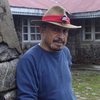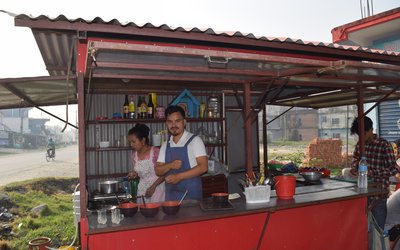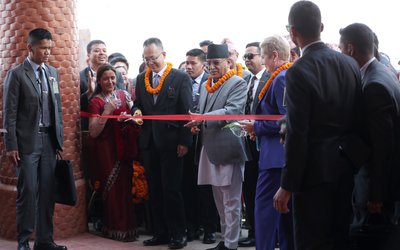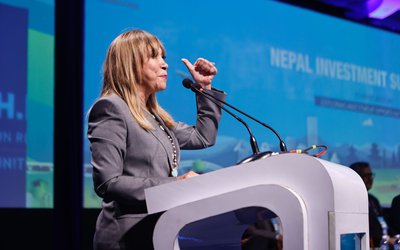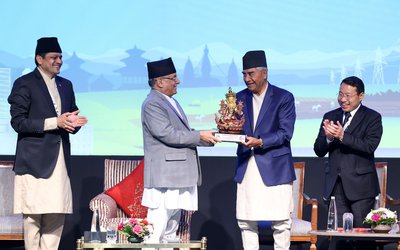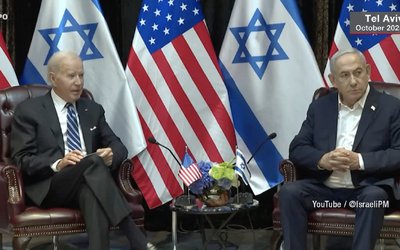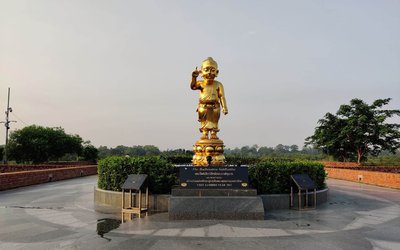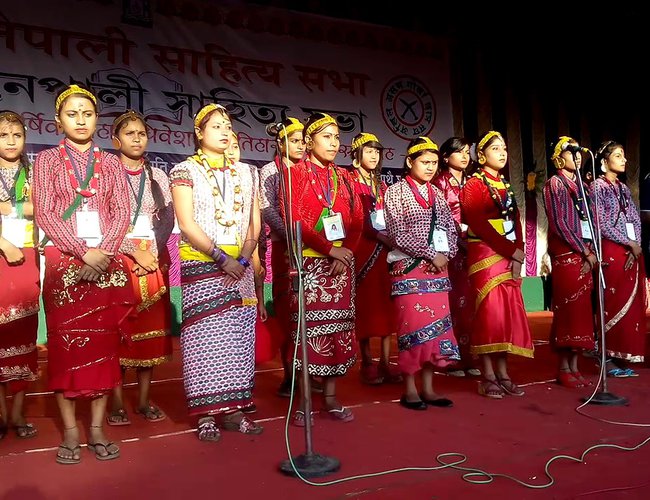
Assam
It is written the Puranic History that Nepal and Kamarup (Assam) was a single domain called Matsyendranath. It is believed that a great mystic yogi of Kamarup, had gone to Nepal and settled there. This ancient link between Nepal and Assam was resurrected in modern times in the 19th Century. In the early days, the Gorkhas were cattle herders in the Assam valley, their grazing grounds spread from Baralimara to Bhavani Devithan. Bura Chapari of Tezpur was declared a professional grazing reserve in 1881.
After the success of tea gardens in Assam
sometimes in 1853, the East India Company started bringing in laborers from
Nepal. Upon passing several legislations in 1863, people from Nepal were given
the freedom to enter tea plantations in Assam. The Gorkha population in Assam
naturally went up and they started to diversify in the fields of farming and
dairy. In 1889, oil was explored in Digboi, Assam and the Gorkhas were employed
mainly for security of the oil fields but since the local people feared to
enter the dense forest around Digboi, Gorkhas were employed for operational
work also. Places surrounding Digboi, such as Itabhatti, Rasthpati, Nalapatti,
Muliabari, Topabasti, Agreement Line, Goru Phatak were all originally inhabited
by Gorkhas. In 1923, Jitbahadur Pradhan was authorized to recruit laborers for
the oil refineries and he brought hundreds of Nepali workers, particularly from
Darjeeling Hills & Doors. Many of those people setelled down in and around
Digboi making it their permanent home.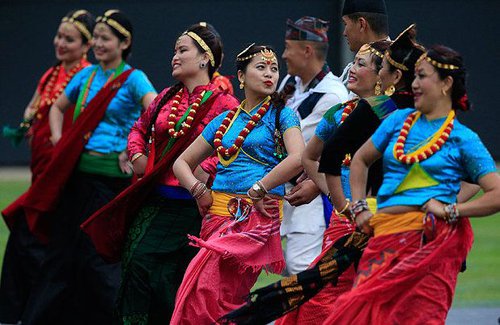
Nagaland
Hari Prasad Gorkha Rai, who is an authority on the Gorkha community in the Northeast India, writes about the genesis of Gorkhas in Nagaland. He states that about 400 hundred years ago, a group of men of Chiechama village, Nagaland were on their way to their fields when they came across three young Gorkha boys, very tired and hungry. The villagers took pity on them and took them back home. After few days two of the boys died of cholera and the one who survived said his name was ‘Rai’. A village elder adopted him and later even married him off to his daughter. In course of time, Rai became assimilated into the Angami tribe and his descendents are now called Metha Tophris, or non ¬Angami Methama clan. Till today, there is a custom amongst the tribe to name the male child as Rayi as a mark of respect to the clan’s original father. In the compound of the 3rd Assam Rifles at Kohima, Nagaland’s capital, there is a memorial stone that places the date of the base’s establishment in 1835. This means the Gorkhas have been in Nagaland since then. When the British marched into Kohima with soldiers from the Native Infantry Cachar Levy and Artillery Force that included Gorkhas, many of these Gorkha soldiers stayed back and were rehabilitated in an area in Kohima that was called Chanmari, meaning firing range. Their descendents still live in the same place.
Manipur
The entry of the Gorkhas and their settlement in Manipur can be traced back to 1819. It is quite probable that some scattered Nepali families were already settled in Manipur before this date. Some scholars push back the history of the Gorkhas in Manipur to the beginning of the 16th Century. Lore also has it that the first Nepali came to Manipur in the beginning of the 10th Century. He married a Meitei girl named Kumbi, from Mayang Heikong Ningol, clan. Since this man reared cows and buffaloes in the Khuti, (goth-cowshed), his descendants are knowns as gotimayan.
The first batch of Gorkhas as a group came to Manipur in 1824, during the time of Raja Gambhir Singh. During this period Gorkhas of the 16th Sylhet Local Battalion, later to become the 8th Gorkha Rifles, were included in the Police Levy of Gambhir Singh. During the first quarter of the 19th Century, Manipur was much troubled by Burmese intruders and their military. To secure his boundaries Gambhir Singh raised an army in 1825 and recruited Gorkhas from Sylhet and this militia was named the Victoria Paltan. This name is a clear indication of the preponderance of Gorkhas in the army during the period as the word paltan is a Nepali corruption of the English platoon. Having earned the trust of the British, Gorkha soldiers were detailed to protect all the Political Agents, the VIPs of those days. They were also brought in as cooks, milkmen, traders and agriculturists.
The number of Gorkha soldiers in Manipur increased when the East India Company moved the 23rd, 43rd and 44th battalions of the 8th Gorkha Rifles to Manipur around 1880. According to the records of the Chief Commissioner of Assam, 400 Gorkha soldiers from Golaghat and 200 from Silchar were also brought in. By 1891, more Gorkhas were relocated to Manipur from other places in Assam. In the beginning of the 20th Century, Gorkhas were being recruited in the Assam Military Police, where 82 of them were posted at Tura in the Garo Hills Battalion, 730 were at Dibrugarh in the Lakhimpur Battalion, 331 at Kohima in the Naga Hills Battalion, 111 at Silchar in the Silchar Battalion and 105 at Dhaka in the Dhaka Battalion. Resultantly, these areas still have large number of Gorkha community; however, their fate in Dhaka after the partition is not clear. In 1915, the 2nd Gorkha Rifles, stationed at Imphal was replaced by the Darang Military Police when the battalion was moved to Europe. This Darang Military Police stationed at Manipur was converted into the 4th Assam Rifles in 1917 that also had 80 percent Gorkha personnel.
Almost all the Gorkhas who came to Manipur on active service settled there permanently after retirement. The British government allotted lands to the personnel of the 4th the Assam Rifles in Thangmaiband and later in special colonies in Eroisembe, Chink, Tangri, Kalapahar, Torbung, Maram, Imphal, Irang and Kanglatombi. After 1945, many Gorkha personnel from INA also made Manipur their home.
In 1894 Nepali literature’s first poetical
work, Manipur Ko Sawai by Tulachand Alay was published in Imphal. It is a proof
that the Gorkhas were fully assimilated into Manipur society and had kept their
own literature enriched even within culturally rich Meiti society.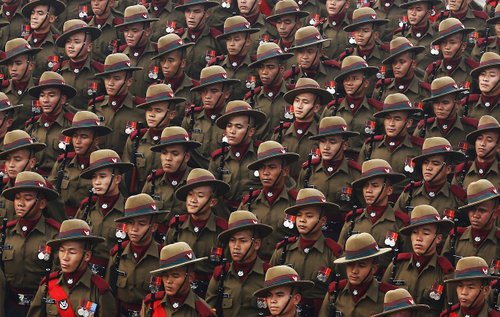
Mizoram
The Gorkhas have been in Mizoram at least for a century and a half. In 1865, Colonel T.H. Lewin wrote, “I had formed a high opinion of the little Gorkhas, who under Col Macpherson had done the fighting of the expedition and I obtained permission to send a party to Nepal and get immigrants from there to colonize this frontier waste.” Perhaps as a follow up Gorkha colonies were established on the Myani River, a northern affluence of the Karnaphuli, now in Bangladesh. Colonel Lewin wanted to establish a number of villages along the plains and the hills so that a well¬ defined boundary between the local and British territories could be established. He further records that the country where the villages were located had previously been uninhabited, for fear of the marauding Lushais, and my idea had been to establish there a good stockade villages of courageous, stiff¬ people like the Gorkhas, who should serve as the buffer between the Mong Raja’s territory and the independent Lushais to the east. After the construction of stockades at Lunglei and Aizawl, peace was restored in most of the hills. The government needed man¬power such as traders, masons, dak¬runners, chowkidars, farmers etc for which they turned to the Gorkhas in Nepal again specially so when they feared that the natives were not yet fully docile, meaning hostile. The Gorkhas also reached Mizoram as personnel of the Frontier Police Battalion. There is a case recorded in 1872 when the Gorkhas rescued Mary Winchester, daughter of the manager of the Alexandrapore Tea Garden, who was abducted by the Lushai chieftains. This act of loyalty won the Gorkhas the trust of the British, who recommended that they settle in the area for good.
The Surma Valley Military Police Battalion, later known as 1st Assam Rifles, was raised at Changsil in the north Lushai Hills by General Tregears in 1889. Its ranks were mainly filled by Gorkha soldiers. The Gorkhas, after their retirement from Assam Rifles, army and the police forces, accepted the Lushai Hills as their homeland and today they form the most socially organized Gorkha community in north¬east India.
Meghalaya
The First known settlement of the Gorkhas in Meghalaya, erstwhile the Khasi¬-Jaintia Hills, can be traced to the establishment of three Gorkha social organizations in Shillong which were, the Gorkha Thakurbari in 1824; Gorkha Durga Puja Committee in 1872 and Gorkha Union in 1886. Chronologically, the Thakurbari appears to be the oldest organization of Gorkhas in the entire Northeast. It still runs two temples and one middle school for girls. The Gorkha Durga Puja Committee was started by the Gorkhas of the 1st and 2nd battalions of 8 GR. In 1940, when the battalions were shifted to Quetta, now in Pakistan, the committee was handed over to the civilians and ex-¬servicemen residing in and around Shillong. Another older organisation is the Gorkha Union, later known as the Gorkha Association. The history of 8th Gorkha Rifles reveals a lot about the Gorkhas in Meghalaya.
Major Alban Wilson writes: In 1845, an outpost of the regiment was established at Umbai in the Khasi Hills, under the command of Subedar Deoraj Alay, who was given the civil powers of a third class magistrate but he died after two years in Umbai, Cherapunji. However in that short time, he had endeared himself so much to the inhabitants that they erected a large tomb over his grave by the road side, and to the present day, every inhabitant of the place worships at his grave, and when passing by, places a chew of supari (beetle nut) on it.
In 1866, Lieutenant W.J. Williamson was appointed the commissioner of Garo Hills. He set up a police force in Tura with two inspectors, two sub ¬inspectors, six head constables and 100 constables. Most of the constables and coolies brought to Tura were Gorkhas from Goalpara in Assam. The Gorkhas were also employed in trees felling and road construction. When the American missionaries on their way to Garo Hills had collected and taken 12 Gorkhas from Dhubri, Assam. A G Phillips, one of the missionaries, wrote in his diary dated 12 December 1876: I am at Tura at last. I left Goalpara November Seventh, reaching Dhubri on the following day, where I stopped to get coolies for building, as this is a place where many Nepali come from Nepal seeking work.
It does seem that Gorkhas had contributed much towards the development of Shillong that came to be known later as the Scotland of the East. Asked what the place was like when he marched into Shillong with the 4th battalion, 8 GR, Captain Kalu Thapa replied, there was not a rat there.
Along with the servicemen, Gorkhas were encouraged move to the North East and rear cattle. Lyndred Shira, a writer based in Tura, discloses this in the following words: “When Tura was first occupied by the American Baptist Mission in 1876, there was hardly anything out here. The present site of the school was a thick jungle, infested with wild and dreaded elephants that roamed at large breaking the silence of the atmosphere with their vocal trumpets. Goshai, a Nepali fellow, must have occupied this plot of land sometimes towards the beginning of this century. He must have been invited by the British Government to start a cattle farm here, purposely for supply of milk to the residents of the locality.” Goshai’s grazing farm was known, till late, as Nippal or ‘Nepali hill’.
In 1872, Shillong had 1,363 inhabitants, 935 in the active service. Of those in the services, 772 were Gorkhas. By now, The Nepalis had made homes in almost all the places of Meghalaya, though there was no single area inhabited fully by them. Manorath Upadhya, a jemadar’ of the Garo Hills Military Police Battalion, wrote a poem, Tirthavali in 1915 which means that just like Manipur, Gorkhas in Garo & Jaintia Hills, present day Meghalaya had established themselves and pursuing their own culture, traditions and literature.
Gorkhas in Assam Rifles
Background: It was during the Anglo Nepal War of 1815-16 that British were very impressed by the valour and fearlessness of the Gorkhas. First incident was the Gorkha success in the Western battle fields in Punjab under the brilliant Gorkha General Amar Singh Thapa and his son Ranjore Singh Thapa. Second incident was the failure of British attack against the mountain fortress of Kalanga held by General Balbhadra and his troops to the extent that even when the assault was personally led by General Gillespie the Gorkhas destroyed the assault while General Gillespie was shot dead by a Gorkha sniper from the fort. The third and the final turning point was on 17 Feb 1815 when a mote group of 200 Gorkhas assaulted with Khukuri 2000 British irregular’s ambush under the command of Lt Fredric Young resulting in fleeing of the entire column of the irregulars and capture of Lt Young. Legend has it that when the Gorkhas asked Lt Young why he did not run away, the young officer replied that he did not come all the way to run away. Here British felt that the Gorkhas were invincible in a battle field and Gorkhas were impressed by the bravery of the young British officer. So impressed were the British with the Gorkhas dare devilry courage that they forced Gen Amar Singh Thapa to agree to the recruitment of Gorkhas in the British Army with handsome salary and perks even before the War ended and treaty of Sagauli was signed on 2nd Dec 1815. Accordingly, it was in 1815 that the first three British Gorkha battalions were raised, 1st Nasiri, 2nd Nasiri and a Sirmoor Battalion.
The Recruitment: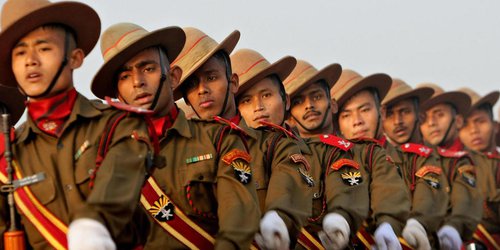
After peace with Nepal, British focused their attention towards the erstwhile Assam Province, now North East, where they were expanding their infrastructure to loot the rich natural resources of the region as also expand their newly formed tea gardens. However, all was not well in the Assam province and it was no cake walk for the British as they thought. British expansion was harassed by the tribal bands of Nagas, Mizos and kukis who used to raid, loot and retreat back to the hills sometimes with heads of the British pioneers. As they were already recruiting Gorkhas and forming Gorkha Battalions in the mainland India, the British recruited more Gorkhas to safeguard their people and expanding infrastructure in the North East. However, the force had to be area specific primarily tasked to guard their expansion into the jungles of the North East. Accordingly, using the manpower of majority Gorkhas recruited from Nepal with addition of Assamese, Kacharies and Bodos, the British raised Assam Rifles in 1835, which was initially known as Kachar Levy. The force had about 80 percent Gorkhas, 10 percent Assamese and 10 percent other tribes of the North East and their task was to guard the Easter frontier from Brahmaputra to Cachar and to carry out small scale punitive expeditions against the raiding tribes of the hill areas. As per the British records, the maintenance of law and order was a whole time ongoing occupation for the force against the unending incidents of violence by the tribal warriors who raided the British tea gardens, murdered British officials, transgressed the recognised boundaries or hunted human heads in the neighbouring villages. British now started recruiting large number of Gorkhas in Assam Rifles and encouraged them to take their families to remote outposts of the NE. Besides being brave, Gorkhas are industrious and good at farming and dairy work. As such, living in those outposts they guarded the British frontiers as also flourished in farming and dairy products. Initially the Assam Rifles drew most of its manpower from Gorkha region of Nepal while the recruitment was carried out by the individual battalions by sending their recruitment parties to Nepal. Later the recruitment was taken over by the recruiting offices in the areas. By then the name, Kachar Levy was changed to Assam Police although the force and the task remained the same. During the 1st World War, Gorkhas in then Assam Police fought most valiantly in France, Egypt, East Africa, Palestine, Mesopotamia, Gallipoli, North Persia and NW Frontier of India. After the First World War in 1917, in recognition of their outstanding services in these battlefields the name of the force was permanently changed to that of Assam Rifles upgrading it from a police force to a paramilitary force.
By 1917 with the expansion of the force the recruitment was done through designated army recruitment offices. Over the years the Assam Rifles multiplied manifold and so did the Gorkhas in it. Encouraged to live with their families the Gorkhas numbers in the North East increased substantially as many opted to settle down in and around their posts that later mushroomed into large villages and towns. As such even today there are large numbers of Gorkhas in various parts of the NE. It needs to be noted that the first Indian Inspector General (now upgraded to Director General) of Assam Rifles was Col Sidhiman Rai, MC, a decorated Gorkha Officer from the Assam Regiment.
